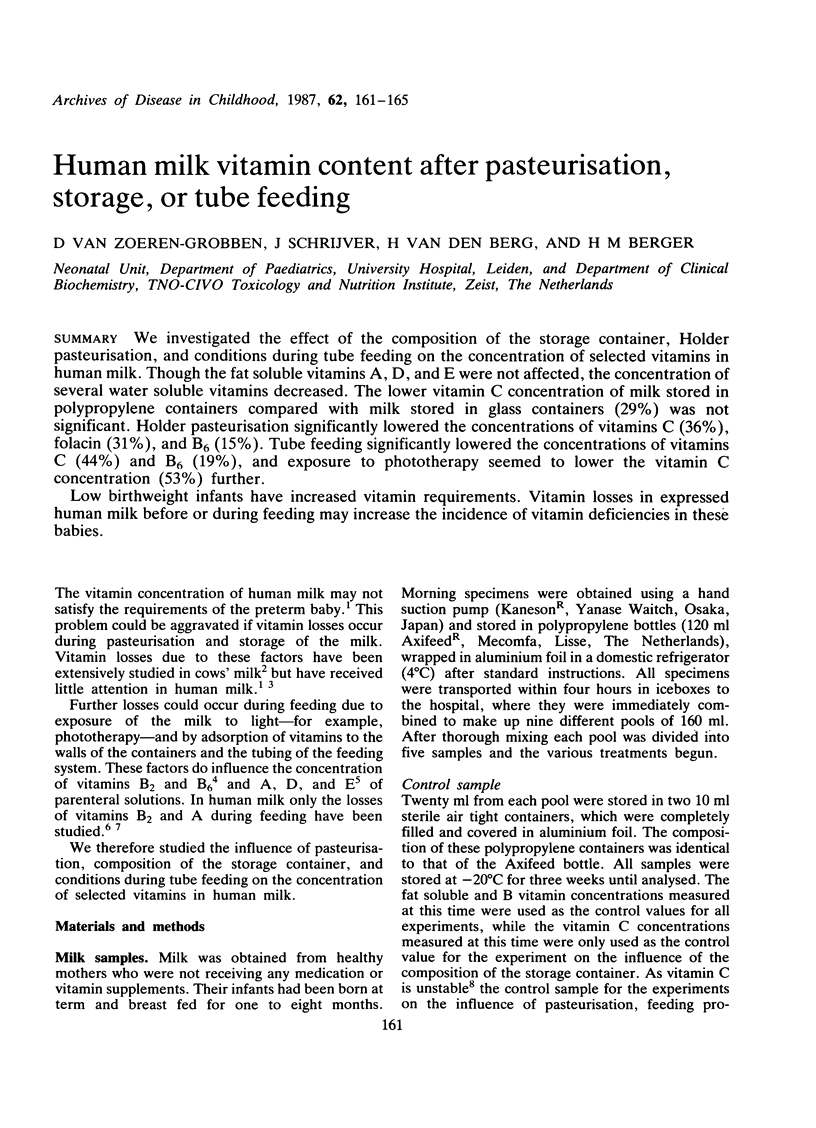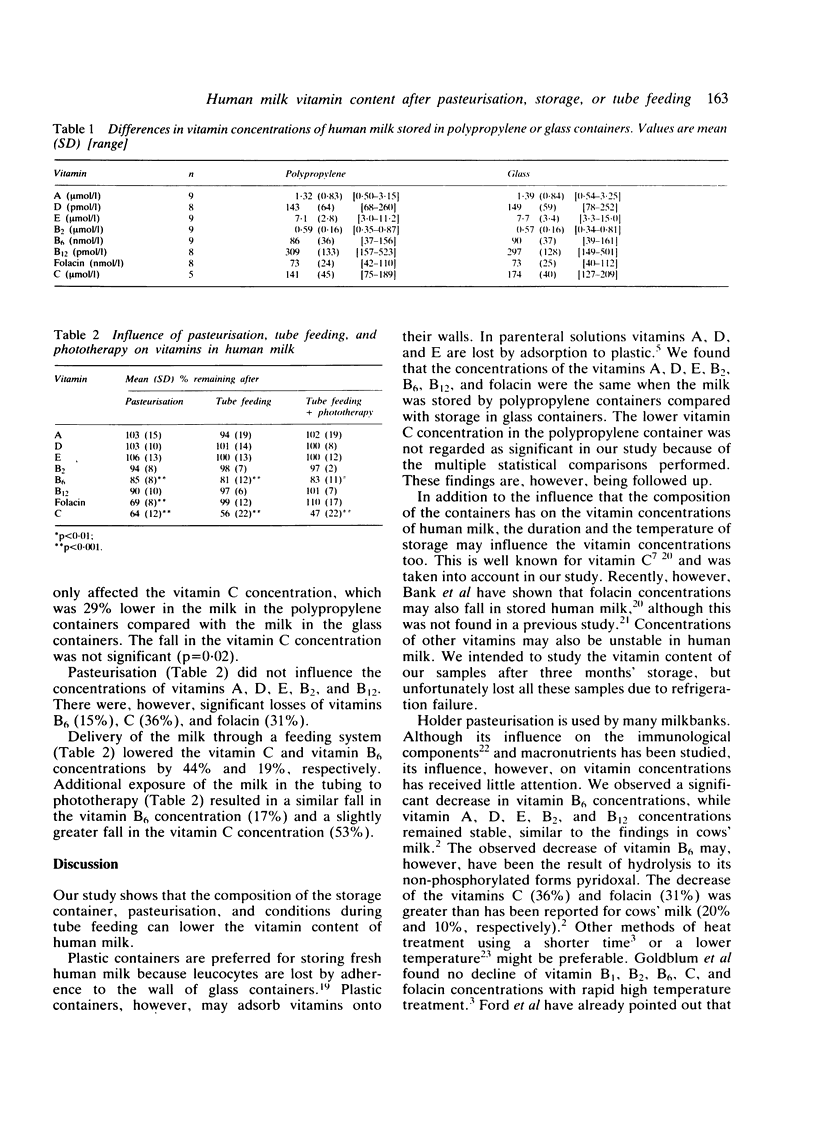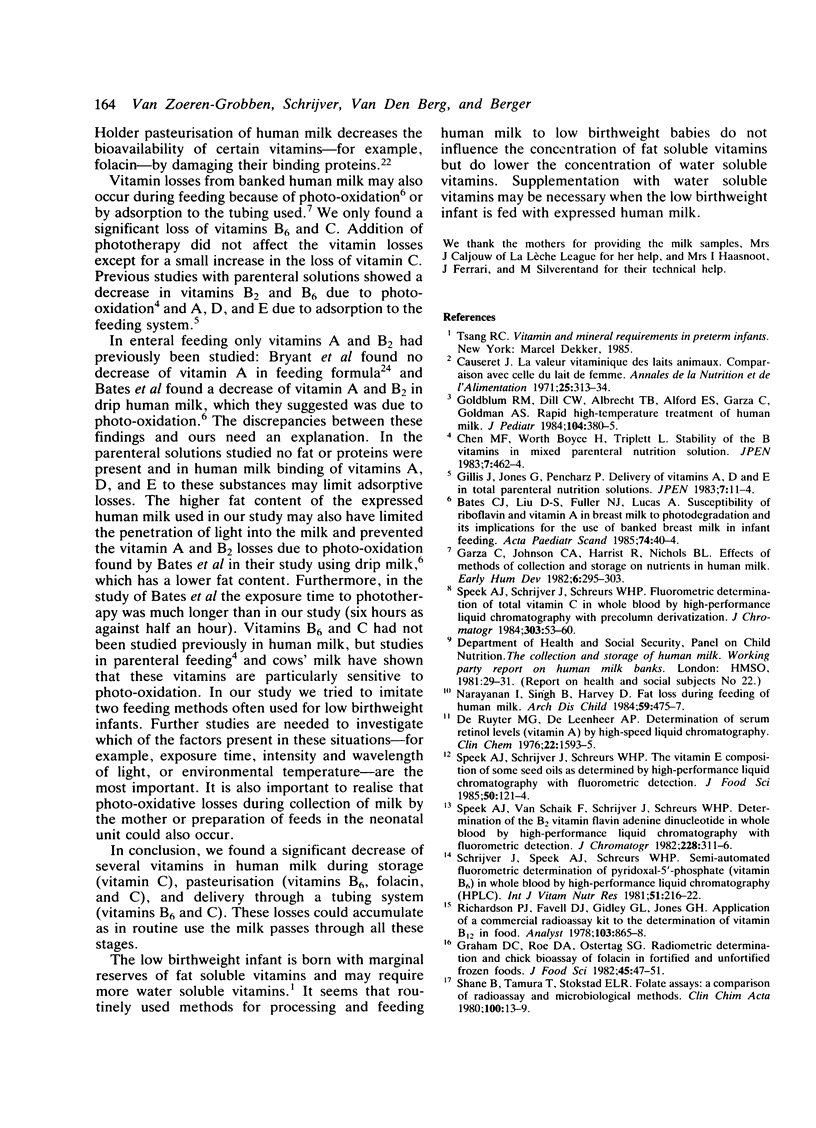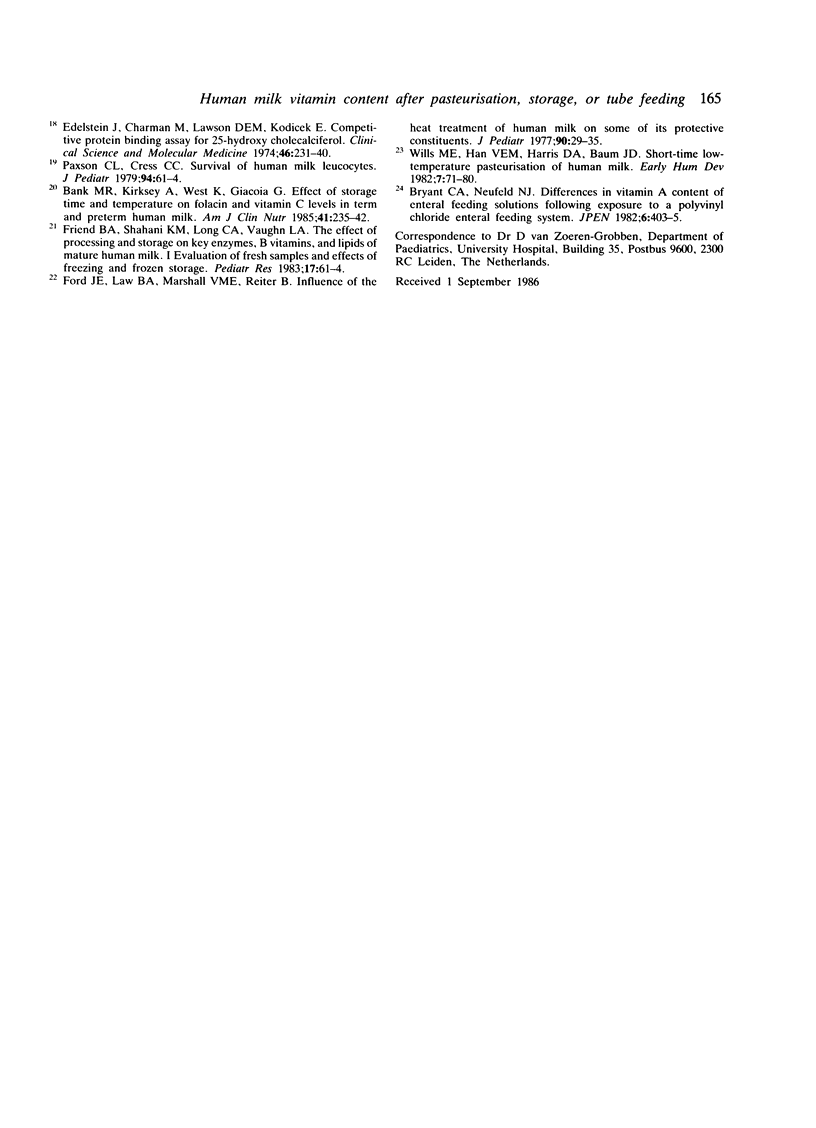Abstract
We investigated the effect of the composition of the storage container, Holder pasteurisation, and conditions during tube feeding on the concentration of selected vitamins in human milk. Though the fat soluble vitamins A, D, and E were not affected, the concentration of several water soluble vitamins decreased. The lower vitamin C concentration of milk stored in polypropylene containers compared with milk stored in glass containers (29%) was not significant. Holder pasteurisation significantly lowered the concentrations of vitamins C (36%), folacin (31%), and B6 (15%). Tube feeding significantly lowered the concentrations of vitamins C (44%) and B6 (19%), and exposure to phototherapy seemed to lower the vitamin C concentration (53%) further. Low birthweight infants have increased vitamin requirements. Vitamin losses in expressed human milk before or during feeding may increase the incidence of vitamin deficiencies in these babies.
Full text
PDF




Selected References
These references are in PubMed. This may not be the complete list of references from this article.
- Bank M. R., Kirksey A., West K., Giacoia G. Effect of storage time and temperature on folacin and vitamin C levels in term and preterm human milk. Am J Clin Nutr. 1985 Feb;41(2):235–242. doi: 10.1093/ajcn/41.2.235. [DOI] [PubMed] [Google Scholar]
- Bates C. J., Liu D. S., Fuller N. J., Lucas A. Susceptibility of riboflavin and vitamin A in breast milk to photodegradation and its implications for the use of banked breast milk in infant feeding. Acta Paediatr Scand. 1985 Jan;74(1):40–44. doi: 10.1111/j.1651-2227.1985.tb10918.x. [DOI] [PubMed] [Google Scholar]
- Bryant C. A., Neufeld N. J. Differences in vitamin A content of enteral feeding solutions following exposure to a polyvinyl chloride enteral feeding system. JPEN J Parenter Enteral Nutr. 1982 Sep-Oct;6(5):403–405. doi: 10.1177/0148607182006005403. [DOI] [PubMed] [Google Scholar]
- Chen M. F., Boyce H. W., Jr, Triplett L. Stability of the B vitamins in mixed parenteral nutrition solution. JPEN J Parenter Enteral Nutr. 1983 Sep-Oct;7(5):462–464. doi: 10.1177/0148607183007005462. [DOI] [PubMed] [Google Scholar]
- De Ruyter M. G., De Leenheer A. P. Determination of serum retinol (vitamin A) by high-speed liquid chromatography. Clin Chem. 1976 Oct;22(10):1593–1595. [PubMed] [Google Scholar]
- Edelstein S., Charman M., Lawson D. E., Kodicek E. Competitive protein-binding assay for 25-hydroxycholecalciferol. Clin Sci Mol Med. 1974 Feb;46(2):231–240. doi: 10.1042/cs0460231. [DOI] [PubMed] [Google Scholar]
- Ford J. E., Law B. A., Marshall V. M., Reiter B. Influence of the heat treatment of human milk on some of its protective constituents. J Pediatr. 1977 Jan;90(1):29–35. doi: 10.1016/s0022-3476(77)80759-2. [DOI] [PubMed] [Google Scholar]
- Friend B. A., Shahani K. M., Long C. A., Vaughn L. A. The effect of processing and storage on key enzymes, B vitamins, and lipids of mature human milk. I. Evaluation of fresh samples and effects of freezing and frozen storage. Pediatr Res. 1983 Jan;17(1):61–64. doi: 10.1203/00006450-198301000-00012. [DOI] [PubMed] [Google Scholar]
- Garza C., Johnson C. A., Harrist R., Nichols B. L. Effects of methods of collection and storage on nutrients in human milk. Early Hum Dev. 1982 Jul;6(3):295–303. doi: 10.1016/0378-3782(82)90123-2. [DOI] [PubMed] [Google Scholar]
- Gillis J., Jones G., Pencharz P. Delivery of vitamins A, D, and E in total parenteral nutrition solutions. JPEN J Parenter Enteral Nutr. 1983 Jan-Feb;7(1):11–14. doi: 10.1177/014860718300700111. [DOI] [PubMed] [Google Scholar]
- Goldblum R. M., Dill C. W., Albrecht T. B., Alford E. S., Garza C., Goldman A. S. Rapid high-temperature treatment of human milk. J Pediatr. 1984 Mar;104(3):380–385. doi: 10.1016/s0022-3476(84)81099-9. [DOI] [PubMed] [Google Scholar]
- Narayanan I., Singh B., Harvey D. Fat loss during feeding of human milk. Arch Dis Child. 1984 May;59(5):475–477. doi: 10.1136/adc.59.5.475. [DOI] [PMC free article] [PubMed] [Google Scholar]
- Richardson P. J., Favell D. J., Gidley G. C., Jones G. H. Application of a commercial radioassay test kit to the determination of vitamin B 12 in food. Analyst. 1978 Aug;103(1229):865–868. doi: 10.1039/an9780300865. [DOI] [PubMed] [Google Scholar]
- Schrijver J., Speek A. J., Schreurs W. H. Semi-automated fluorometric determination of pyridoxal-5'-phosphate (vitamin B6) in whole blood by high-performance liquid chromatography (HPLC). Int J Vitam Nutr Res. 1981;51(3):216–222. [PubMed] [Google Scholar]
- Shane B., Tamura T., Stokstad E. L. Folate assay: a comparison of radioassay and microbiological methods. Clin Chim Acta. 1980 Jan 1;100(1):13–19. doi: 10.1016/0009-8981(80)90180-1. [DOI] [PubMed] [Google Scholar]
- Speek A. J., Schrijver J., Schreurs W. H. Fluorometric determination of total vitamin C in whole blood by high-performance liquid chromatography with pre-column derivatization. J Chromatogr. 1984 Jan 13;305(1):53–60. doi: 10.1016/s0378-4347(00)83313-7. [DOI] [PubMed] [Google Scholar]
- Speek A. J., van Schaik F., Schrijver J., Schreurs W. H. Determination of the B2 vitamer flavin--adenine dinucleotide in whole blood by high-performance liquid chromatography with fluorometric detection. J Chromatogr. 1982 Mar 12;228:311–316. doi: 10.1016/s0378-4347(00)80446-6. [DOI] [PubMed] [Google Scholar]
- Wills M. E., Han V. E., Harris D. A., Baum J. D. Short-time low-temperature pasteurisation of human milk. Early Hum Dev. 1982 Oct;7(1):71–80. doi: 10.1016/0378-3782(82)90009-3. [DOI] [PubMed] [Google Scholar]


